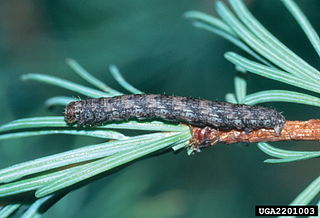
Ghelna is a genus of North American jumping spiders that was first described by Wayne Paul Maddison in 1996.
Antona is a genus of moths in the subfamily Arctiinae. The genus was erected by Francis Walker in 1854.

Rioxa is a genus of tephritid in the family Tephritidae. The genera Rioxa and related Hexacinia and Cribrorioxa are distributed in South and Southeast Asia from India and Sri Lanka in the west to the Philippines. Only a few species extend east of Borneo to New Guinea and the Bismarck Archipelago. Rioxa breeds on fallen logs inside forests.

Macaria sexmaculata, known by the common names green larch looper, larch looper or six-spotted angle, is a moth of the family Geometridae. It is found from Alaska to Nunavut and Newfoundland, south in the east to Massachusetts and south in the west to Oregon.

Cheilomenes is a genus of ladybirds (Coccinellidae). Like other members of their subfamily they are large typical ladybirds. They are always shiny and often have bright spots on the elytra. The common African species C. lunata is an important predator of the citrus aphid, Toxoptera, and wheat aphid, while C. vicina has been suggested as a biological control agent for the cowpea aphid. Both the larvae and adults are predatory. Freshly emerged larvae consume unhatched eggs, and eventually have a dappled appearance and 6 tubercles on each abdominal segment. Vulnerable stages in the life of C. sexmaculata, including oviposition, hatching, moulting and pupation have been shown to occur after dark, probably as an adaptation to avoid exposure to natural enemies.
Antona sexmaculata is a moth of the subfamily Arctiinae first described by Arthur Gardiner Butler in 1877. It is found in the Amazon basin.

Cephalopholis sexmaculata, sixblotch hind, freckled cod, freckled rock-cod, sixband cod, six-banded rockcod, sixband rockcod or sixspot rockcod is a species of marine ray-finned fish, a grouper from the subfamily Epinephelinae which is in the family Serranidae which also includes the anthias and sea basses. This fish occurs throughout the Indo-Pacific region.

Anthia sexmaculata, common name Egyptian predator beetle, is a species of beetles of the family Carabidae.

Palpopleura sexmaculata, commonly known as the Asian widow or blue-tailed yellow skimmer, is a species of dragonfly in the family Libellulidae. It is widespread in several countries in South, East and Southeast Asia, but is no longer believed to occur in Sri Lanka.

Pseudohomaloptera is a genus of ray-finned fish in the family Balitoridae.
Pseudohomaloptera sexmaculata is a species of the genus Pseudohomaloptera in the family Balitoridae.
Colobothea sexmaculata is a species of beetle in the family Cerambycidae. It was described by Per Olof Christopher Aurivillius in 1902 and is known from Brazil.
Sangaris sexmaculata is a species of beetle in the family Cerambycidae. It was described by Monné in 1993. It is known from Peru.

Capraita sexmaculata, the Charlie Brown flea beetle, is a species of flea beetle in the family Chrysomelidae. It is found in North America.
Hermetia sexmaculata is a species of soldier fly in the family Stratiomyidae.

Prometopia sexmaculata is a species of sap-feeding beetle in the family Nitidulidae. It is found in North America.

Perdita sexmaculata is a species of bee in the family Andrenidae. It is found in Central America and North America.

Agraylea multipunctata, the salt and pepper microcaddis, is a species of microcaddisfly in the family Hydroptilidae. It is found in Europe and Northern Asia.

Agraylea is a genus of microcaddisflies in the family Hydroptilidae. There are more than 20 described species in Agraylea.

Cheilomenes sexmaculata is a species of ladybird. Although sometimes known by the common name of six-spotted zigzag ladybird, this is misleading as there are several colour morphs and some colour morphs of the species can be confused with Micraspis discolor and Chilocorus nigrita. The species has a wide distribution range within the Asian tropics and subtropical zones from India to Japan and parts of the Australian region. They have been introduced into the Caribbean islands as a biocontrol agent and their spread to South America was noted in 2019. It is well known as a predator of aphids and other small insects.












